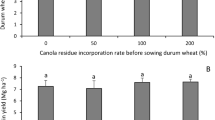Abstract
In trials conducted at 2 highland Vertisol sites in Ethiopia in 1990 and 1991, 2 locally popular wheat cultivars, 1 spring bread wheat (Triticum aestivum L.) and 1 durum wheat (T. durum Desf.), were supplied with nitrogen (N) fertilizer at 0, 60 and 120 kg N ha−1 in the form of large granular urea (LGU), standard urea prills or ammonium sulfate. N was applied all at sowing, all at mid-tillering or split-applied between these two stages (1/3:2/3). While durum wheat exhibited the highest N concentration in grain and straw, bread wheat, because of its higher productivity, resulted in a greater grain and total N uptake. In general, split application of N and use of LGU as N source enhanced grain and total N uptake, apparent N recovery and agronomic efficiency of N, particularly under severe water-logging stress. Where significant, the interactions among the experimental factors substantiated the superior responsiveness of the bread wheat cultivar to fertilizer N, and the beneficial effects of split N application and LGU as an N source. Split application of N tended to nullify the positive effects of LGU, presumably by approximating the delayed release of N achieved with LGU. Considering the potential benefits to Ethiopian peasant farmers and consumers, split application of N should be advocated, particularly on water-logged Vertisols; LGU could be an advantageous N source assuming a cost comparable to the conventional N source urea.
Similar content being viewed by others
References
Alcoz MM, Hons FM and Haby VA (1993) Nitrogen fertilization timing effect on wheat production, nitrogen uptake efficiency, and residual soil nitrogen. Agron J 85: 1198–1203
Asnakew Woldeab, Tekalign Mamo, Mengesha Bekele and Teferra Ajema (1991) Soil fertility management studies on wheat in Ethiopia. In: Hailu Gebre-Mariam, Tanner DG and Mengistu Hulluka (eds) Wheat Research in Ethiopia: A Historical Perspective, pp 137–172. IAR/CIMMYT, Addis Ababa, Ethiopia
Bock BR (1984) Efficient use of nitrogen in cropping systems. In: Hauck RD (ed) Nitrogen in Crop Production, pp 273–294. American Society of Agronomy, Madison, Wisconsin
Braun H and Roy RN (1983) Maximizing the efficiency of mineral fertilizers. In: Efficient Use of Fertilizers in Agriculture, Developments in Plant and Soil Sciences, Vol. 10, pp 251–271. The United Nations, New York
Campbell CA, Nuttall W, Ukrainetz H, Selles F and Wright T (1991) Effect of N source, placement and time of application on winter wheat production in Saskatchewan. Can J Soil Sci 71: 177–187
Campbell CA, Selles F, Zentner RP and McConkey BG (1993) Nitrogen management for zero-till spring wheat: disposition in plant and utilization efficiency. Commun Soil Sci Plant Anal 24: 2223–2239
Doyle AD and Holford ICR (1993) The uptake of nitrogen by wheat, its agronomic efficiency and their relationship to soil and fertilizer nitrogen. Aust J Agric Res 44: 1245–1258
Fischer RA, Howe GN and Ibrahim Z (1993) Irrigated spring wheat and timing and amount of nitrogen fertilizer. I. Grain yield and protein content. Field Crops Res 33: 37–56
Hailu Gebre-Mariam (1991) Wheat production and research in Ethiopia. In: Hailu Gebre-Mariam, Tanner DG and Mengistu Hulluka (eds) Wheat Research in Ethiopia: A Historical Perspective, pp 1–15. IAR/CIMMYT, Addis Ababa, Ethiopia
Kamara CS and Haque I (1987) Characteristics of Vertisols at ILCA research sites in Ethiopia, ILCA Working Document No. B5. ILCA, Addis Ababa, Ethiopia
Legg JO and Meisinger JJ (1982) Soil nitrogen budgets. Agron J 22: 503–566
Malhi SS and Nyborg M (1992) Recovery of nitrogen by spring barley from ammonium nitrate, urea and sulphur-coated urea as affected by time and method of application. Fert Res 32: 19–25
Meelu OP, Saggar S, Maskina MS and Rekhi RS (1987) Time and source of N application in rice and wheat. J Agric Sci 109: 387–391
Miressa Duffera, Tekalign Mamo, Mesfin Abebe and Samuel Geleta (1992) Response of four wheat varieties to N on highland pellic Vertisols in Ethiopia. In: Tanner DG and Mwangi W (eds) Seventh Regional Wheat Workshop for Eastern, Central and Southern Africa, pp 480–488. CIMMYT, Nakuru, Kenya
Mooleki SP and Foster RK (1993) Effects of N and P rates and proportional timing of N application on rainfed wheat in Zambia. Plant and Soil 149: 73–86
Murthy AS (1988) Distribution, properties and management of Vertisols in India. Adv Soil Sci 8: 151–214
Pearson CJ and Muirhead WA (1984) Nitrogen uptake. In: Pearson CJ (ed) Control of Crop Productivity, pp 73–88. Academic Press, Sydney
Prasad R and Singh S (1985) Relative efficiency of urea and urea supergranules for irrigated wheat. J Agric Sci 105: 693–695
Recous S, Machet JM and Mary B (1992) The partitioning of fertilizer N between soil and crop: comparison of ammonium and nitrate applications. Plant and Soil 144: 101–111
Schulthess U (1992) The impact of Vertisol management systems on wheat production in the Ethiopian highlands, PhD thesis. Swiss Federal Institute of Technology, Zurich
Tanner DG, Amanuel Gorfu and Asefa Taa (1993) Fertilizer effects on sustainability in the wheat-based small-holder farming systems of southeastern Ethiopia. Field Crops Res 33: 235–248
Tesfaye Tesemma and Jamal Mohammed (1982) Review of wheat breeding in Ethiopia. Eth J Agric Sci 4: 11–24
Tilahun Geleto (1994) The effects of nitrogen fertilizer sources, rates and time of application on the nitrogen uptake, grain yield and yield components of wheat, MSc thesis. Alemaya University of Agriculture, Ethiopia
Tilahun Geleto, Tanner DG, Tekalign Mamo and Getinet Gebeyehu (1995) Response of rainfed bread and durum wheat to source, level and timing of nitrogen fertilizer on two Ethiopian Vertisols: I. Yield and yield components. Comm Soil Sc Plant Anal 26(11-12): 1773–1794
Vaughan B, Westfall DG and Barbarick KA (1990) Nitrogen rate and timing effects on winter wheat grain yield, grain protein, and economics. J Prod Agric 3: 324–328
Author information
Authors and Affiliations
Rights and permissions
About this article
Cite this article
Geleto, T., Tanner, D.G., Mamo, T. et al. Response of rainfed bread and durum wheat to source, level and timing of nitrogen fertilizer on two Ethiopian Vertisols: II. N uptake, recovery and efficiency. Fertilizer Research 44, 195–204 (1995). https://doi.org/10.1007/BF00750926
Received:
Accepted:
Issue Date:
DOI: https://doi.org/10.1007/BF00750926




